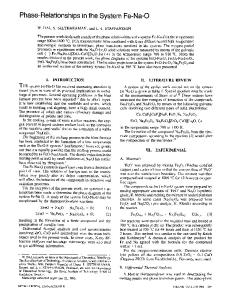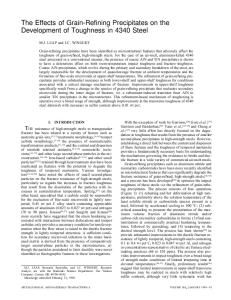The Grain Refining of Aluminum and Phase Relationships in the Al-Ti-B System
- PDF / 485,851 Bytes
- 6 Pages / 594 x 774 pts Page_size
- 78 Downloads / 322 Views
I.
INTRODUCTION
ALUMINUM-titanium master alloys are added in relatively small amounts to refine the grain structure of aluminum and aluminum alloy castings. Experimental studies of the grain refining effect 1'2 show that the intermetallic phase TiA13 is an extremely efficient nucleant. In the presence of TiA13 the undercooling for the formation of solid aluminum is only a few degrees Celsius; and since the AI-Ti phase diagram is peritectic, the first solid metal to be nucleated appears above the liquidus temperature existing in the alloy before the titanium addition. Grain refiner additions are typically made at titanium contents fifteen to thirty times smaller than the peritectic composition, so the TiAI3 particles introduced by the master alloy slowly dissolve. Hence, the grain refining effect fades with time and disappears when the dissolution of the active TiA13 is complete. Our commercial experience shows that boron additions to the A1-Ti master alloy change the performance of the master alloy markedly. There is usually a finer grain size in the casting shortly after the grain refiner addition, and fading is slowed considerably. There have been numerous explanations offered in the literature for why boron improves the grain refining ability of A1-Ti alloys. They can be categorized into three classes. 1. Phase Diagram Theory: Two possibilities have been proposedf1-5 One is that boron alters the phase diagram to allow the peritectic reaction: Liquid + TiA13--~ Solid to occur at titanium contents much less than the 0.15 wt pct found in the AI-Ti binary system. In other words, the solubility of TiA13 is somehow decreased. The other possibility is that TiB2 somehow nucleates TiA13 during cooling, perhaps by a ternary monotectic reaction: Liquid l + TiB2 ~ TiA13 + Liquid 2 2. Boride Theory: Boron forms TiB2, which has low solubility and acts as an effective grain refining agent. 6'7 3. (A1, Ti)B2 Phase Theory: A metastable phase, (AI, Ti)B2, forms, and either acts directly as a grain refining agent, 8,9'm~or somehow alters the phase relationships as in (1) above. ~ GEOFFREY K. SIGWORTH is Senior Research Engineer, Cabot Corporation, Reading Technology Department, P.O. Box 1296, Reading, PA 19603. Manuscript submitted January 27, 1983. METALLURGICALTRANSACTIONS A
It is beyond the scope of this paper to give a detailed exposition of the merits and shortcomings of these theories. The grain refining of aluminum has received intense scientific scrutiny for forty years, so a comprehensive discussion would necessarily be quite lengthy. The reader interested in more detail is referred instead to published reviews. 9a2'13 Nevertheless, it can be stated quite clearly that the phase diagram in the ternary AI-Ti-B system has not been established with certainty. In order to shed light on the role of boron in grain refining, this study of the phase relationships has been made. First, past attempts to establish the phase relationships are reviewed, and then phase diagram calculations are made on the basis of simple and reasonab
Data Loading...











